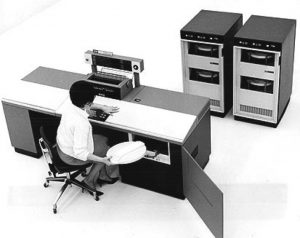History (1965): IBM 2310 Disk Drive and 2315 Cartridge
Firsts with voice coil motor
This is a Press Release edited by StorageNewsletter.com on June 14, 2018 at 2:21 pmThis article comes from the Computer History Museum.
1965 IBM 2310 Disk Drive and 2315 Cartridge
First Cartridge Disk Drive
First Voice Coil Motor
It was developed under the code name RAMKIT and first shipped as the 2310.

Although 14-inch disk cartridges were not technologically significant (utilized heads and disks from 2311 and 2314 programs), they were sold in enormous volumes to the emerging minicomputer and small office system environments.
Cartridges were pioneering efforts to bring HDD technology into small computer environments. Typical users included CPAs, law firms, military, etc. Many of these users kept each client or project on a separate cartridge, preferring security over efficiency, thereby generating a substantial media demand.
The 2310 had a full profiled phase plane servo with a conventional cylindrical VCM, fixed magnet and moving coil. It used the same tachometer as the 3330 but an external position transducer instead of a servo surface.
Some drawbacks of the 2315 cartridge were resolved with a second generation model 5440 used on the IBM System-3 and equivalents. The 5440 design was ‘top loaded’ similar to the 1311 and 2311 disk pack drives, with the cartridge loaded vertically after removing the bottom cover. This design was more contamination resistant, but required the top of the drive to be free of obstacles. Many users preferred the 2315 ‘front loader’ which was inserted by pushing the cartridge into a slot (similar concept to VHS tape deck) without need for a bottom cover.
Highlights:
- First use of a Voice Coil Motor (VCM) for accessing heads across the disk
- Cartridges brought HDD technology from mainframes into small office environments
- Sold in high numbers, and cartridges had high multiples per drive.
- Provided same data portability advantage to small business as enjoyed by large data centers
- Media was inexpensive, lightweight, and portable
- Readily adopted, duplicated, and sold by other minicomputer makers (e.g. Burroughs, DEC)
Lowlights:
- More easily mistreated by unskilled office staff (e.g. dropped, contaminated)
- Stored in uncontrolled areas, more subject to contamination
- Single disk had relatively small data capacity (2 surfaces versus 10-20) compared to disk packs
- In operation it was possible to burn out the voice coil.
“Well one of the amusing things here was that as Andy [Gabor] started … trying to install this 1130 [it] turned into a bit of a marathon. Each time they’d start it up it would run for a little while and then smoke would start to come out of it. And that happened a couple of times before a higher level service person was brought in. What was happening was that the voice coil actuator for the … [2310] disk drive of the 1130 was being toasted. Now why would a voice coil in a disk drive get toasted? The answer turned out to be that the accountant had installed his computer with a line printer but we didn’t need a line printer so we had just decided to use .. our console serial printer, an IBM Selectric typewriter, and dispense with the line printer expense. Well it turned out that the software didn’t get changed accordingly and consequently when you turned the thing on the disk drive would spend its time looking for the software that controlled that printer that wasn’t there. And after some length of time, an hour or two or whatever, the voice coil was hot enough that it burst into flames. Smoke came pouring out and so on. Took them a little while to find that and they had to replace – they did three replacements of voice coils before they got it straight. ” [Oral History of George Comstock CHM Ref: X2727.2004 Page 29 of 50]
Additional Information:
1130 Product Announcement Letter
Technical Announcement Letter
IBM 1130 Archive Web Site
IBM1130.org and IBM1130.net
Moderator: Bill Carlson
Contributors: R. Oswald, T. Gardner
Approved: Storage SIG Meeting June 21, 2011














 Subscribe to our free daily newsletter
Subscribe to our free daily newsletter


